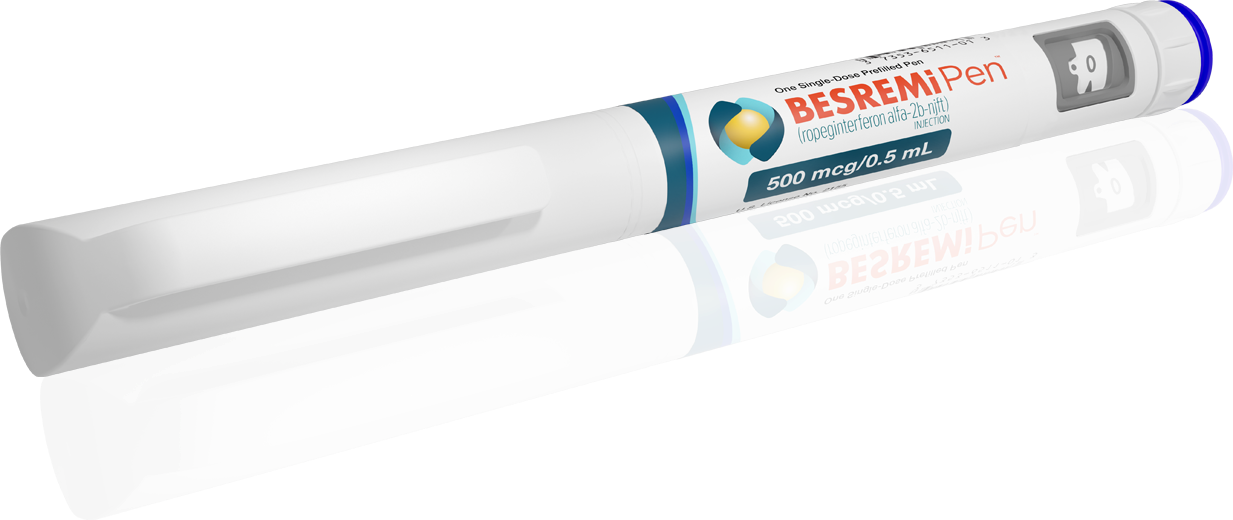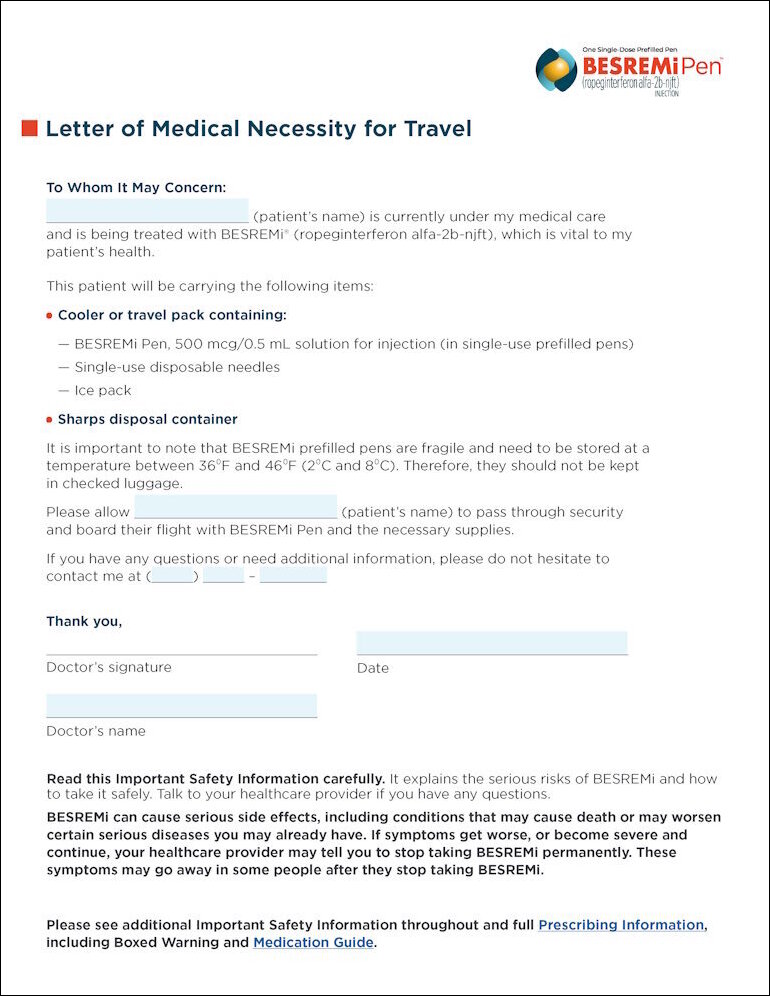


BESREMi PEN


BESREMi is a prescription medicine that is used to treat adults with polycythemia vera
Get notified

Resources to help prepare you and keep you on track
We're here to support you on your journey with polycythemia vera (PV) and BESREMi. Explore our downloadable guides and educational tools below to help you feel more confident and informed every step of the way.

Your Guide to BESREMi
Want to understand how BESREMi helps you take control of PV? Our brochure breaks down the basics, helping you and your loved ones learn about this path forward together.

What to Expect Guide
Find practical tips for getting started with BESREMi, including how to manage any potential side effects and when you can expect to start seeing results.

Doctor Discussion Guide
Are you ready to talk to your doctor about BESREMi? This guide offers helpful questions and topics to empower and prepare you for those conversations.
Pen Instructional Video
Learn how to use BESREMi Pen™ with confidence. This video provides helpful tips and shows you exactly what to expect, so you feel prepared to self-administer.

Pen Instructions for Use
Our easy-to-follow, step-by-step instructions on how to use BESREMi Pen will help guide you through the process.

Travel Letter
If you’re flying with BESREMi, this letter can help you explain your medication needs to airport security to ensure smoother travel.
Treatment Tracker Sheets
Ran out of pages in the treatment tracker notepad from your Welcome Kit? Print more sheets to detail each treatment.
Using the BESREMi prefilled syringe?
Talk to your doctor about switching to BESREMi Pen, but use these resources in the meantime.
Syringe Instructional Video
Learn how to use the BESREMi prefilled syringe with confidence. This video provides helpful tips and shows you exactly what to expect, so you feel prepared to administer your treatment.

Syringe Instructions for Use
Our easy-to-follow, step-by-step instructions on how to give yourself an injection with the BESREMi prefilled syringe will help guide you through the process.
Glossary of PV terms
Get to know some key words you may hear or see when learning about PV and BESREMi.
Blood cells
Types of cells that support various functions in the body. Created in the bone marrow, they begin as stem cells and mature into red blood cells, white blood cells, and platelets.
Bone marrow
The soft, spongy tissue inside bones that makes blood cells.
Cardiovascular events
Incidents that can damage the heart and blood vessels, such as a heart attack or stroke.
Chemotherapy
A treatment that uses drugs to kill cancer cells or slow their growth.
Complete hematologic response (CHR)
When all blood cell counts have returned to normal levels, typically after treatment for a blood-related condition.
Comprehensive disease control (CDC)
When all blood cell counts and spleen size have returned to normal and there is an absence of thromboembolic events, typically after treatment for a blood-related condition.
Efficacy
The ability of a treatment to produce the desired result.
Hematocrit (HCT)
The percentage of red blood cells in your blood.
Hydroxyurea (HU)
A type of chemotherapy that reduces the production of abnormal blood cells and lowers the risk of blood clots.
Immunotherapy
A treatment that uses certain parts of the body's immune system to fight disease.
Interferon
A protein that helps control cell growth and regulate the immune system.
JAK2
A gene that helps make a protein that controls cell growth, especially blood cells.
JAK2 mutation
A change in the JAK2 gene that can lead to blood disorders where the blood makes too many blood cells.
Leukemia
A type of cancer that starts in the blood or bone marrow and causes the body to rapidly produce abnormal white blood cells.
Myelofibrosis (MF)
A rare type of cancer that starts in the bone marrow, leading to scarring and making it harder to produce blood cells.
Myeloproliferative neoplasms (MPNs)
Blood cancers in which the bone marrow makes too many blood cells.
Phlebotomy (PHL)
A procedure of drawing blood to reduce excess blood cells and decrease blood volume.
Platelets
Small cell fragments that help form clots and stop bleeding.
Red blood cells (RBC)
A common type of blood cell that delivers oxygen to the rest of the body.
Stem cells
Cells in the body that can develop into different types of cells.
Thrombotic events
Situations where blood clots form in a blood vessel or the heart, which can block blood flow.
Thromboembolic events
Situations where a blood clot breaks loose and travels to another part of the body, causing a blockage.
White blood cells (WBC)
A type of blood cell that helps the body fight infections and disease.
Advocacy groups to aid your journey
You're not alone. If you're living with PV, there are a variety of advocacy groups dedicated to supporting you and your loved ones. Select a group below to learn more.
Please note: PharmaEssentia is not responsible for the content or availability of linked websites. The information provided by PharmaEssentia is for informational purposes only and is not meant to replace the advice of a healthcare professional.










